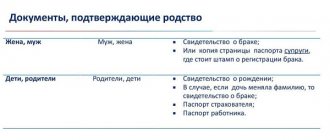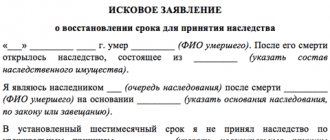Establishing the fact of death in court is a judicial process, as a result of which the relatives of the deceased citizen receive a document confirming the fact of death. After the court decision comes into force, consequences similar to biological death occur. How to recognize a citizen as dead, where to go, what documents to collect and what consequences will occur, read our article.
- Reasons for establishing the fact of death
- Who can be the plaintiff
- Algorithm of actions
Reasons for establishing the fact of death
The purpose of establishing the fact of death is the onset of legal consequences that occur in the event of the death of a citizen.
Legal consequences of the death of a citizen
| No. | Consequences |
| 1 | Opening an inheritance |
| 2 | End of marriage |
| 3 | Recognition of children left without parental care |
| 4 | Removing a citizen from registration |
| 5 | Stopping the accrual of alimony payments both to and from the deceased |
| 6 | Possibility of privatization of residential premises |
| 7 | Stopping utility bills |
| 8 | Registration of pensions or benefits for dependents |
As a rule, the fact of death is established on the basis of a medical death certificate. It is issued by the clinic at the place of last residence of the deceased.
Important! If a death certificate was issued but was lost, then a duplicate must be issued. The procedure for restoring a certificate can be read in the article: “How to restore a death certificate.”
Establishment of the fact of death in court is formalized if it is impossible to obtain a death certificate in the usual way. For example, if a person was washed away from a boat while going down a mountain river. Many people witnessed the death, but the body could not be found. Since the body is missing, the medical institution cannot confirm death and issue a document.
Due to the lack of a document, the heirs cannot dispose of the property of the deceased. The absence of the owner prevents the issue of registration in the apartment, concluding agreements with utility companies, closing loans, and selling property.
Opening of inheritance according to Art. 1113 of the Civil Code of the Russian Federation is possible only after registering the death of a citizen. In the absence of a certificate, the notary will refuse to accept the application from the heirs.
The absence of a breadwinner for minors and disabled dependents deprives them of a source of income. While obtaining a state benefit or pension is impossible.
The actual absence of a parent leads to neglect and homelessness of his children. At the same time, it is impossible to transfer them to the family device, since the parent is considered alive.
Ownerless property of the deceased according to Art. 1151 of the Civil Code of the Russian Federation is recognized as escheat. Inaction of relatives can lead to the loss of property of the missing citizen.
Features of establishing the fact of death
Example. At the time of the shipwreck, a mast fell on one of the passengers. This was seen by many passengers who later escaped. The body of the deceased was washed out to sea and was not found. However, based on the testimony of witnesses, the fact of death is established by the court. The date of death will be the day of the actual death of the citizen.
The district registry office cannot issue a death certificate in such a situation. The reason for refusal may be the lack of a medical report (Article 64 of Federal Law No. 143). The medical institution cannot issue a medical certificate, since in fact the body is missing. Therefore, the heirs have to go to court to establish the fact of death.
Important! The fact of death can only be established if there is irrefutable evidence of the death of a citizen.
What confirms the fact of death
Any legal fact is confirmed by relevant documents. For example, the birth of a baby is confirmed by a birth certificate. A marriage between a man and a woman is confirmed by a marriage certificate.
Proof of a person's death is a medical death certificate or a court order. The first document is issued by the registration authority. Interested parties simply need to submit an application to the Civil Registry Office and pay the state fee.
A medical certificate is attached to the application. The procedure for its issuance is established by letter of the Ministry of Health and Social Development of 2009 No. 14-6/10/2-178. The certificate is issued to family members or other relatives of the deceased citizen. You can obtain a certificate from the morgue that certified the death of an individual. You must have with you the applicant's identity card, the passport of the deceased citizen and his outpatient card.
The second document is issued to the applicant following the trial. The court decision and medical certificate are interim in nature. The applicant will later need to contact the registry office and obtain a death certificate.
Appointment of a trustee for the property of a citizen declared deceased
The identification of a person capable of exercising control and management of property is one of the legal consequences when a citizen goes missing. A trustee for the property of an absent person is appointed by the guardianship structures with the permission of the court (Part 2 of Article 278 of the Code of Civil Procedure of the Russian Federation).
The provisions of this article establish that the appointment process can be carried out immediately after accepting the application from the interested person.
The trustee is established by the territorial guardianship departments.
The appointment procedure is carried out by a judicial authority.
The rights and obligations of the manager are regulated by the trust agreement concluded between the guardianship authority and the manager. A citizen who has signed such a contract has the right to perform certain actions in the interests of the disappeared person, including transactions of a civil law nature.
How to establish the fact of death in court
Judicial proceedings are opened upon the application of an interested person. Certain circumstances must exist in order to file a claim. The person applied to the registry office and was refused to issue a certificate.
Procedure
- Contacting a medical organization.
- Collection of evidence confirming the death of the owner.
- Preparing a claim.
- Trial.
Contacting a medical organization
If a citizen has died, but his body has not been found, then the interested person must submit an application for the issuance of a medical death certificate to the medical institution at the place of last registration of the citizen (clinic, morgue).
The organization will issue a written refusal to issue the document, since in fact the body of the deceased is missing. The refusal must be attached to the statement of claim.
Contacting the regional registry office
The next step is to contact the district registry office with an application to register the death. Specialists will issue a written refusal, since there is no medical certificate of death.
Collection of evidence
As evidence, irrefutable information about the death of a citizen is required. Among them:
- witness statements;
- video recording;
- photos;
- other information that proves the death.
Important! The evidence varies greatly depending on the specific situation.
Statement
An application to establish the fact of death is submitted to the court at the place of registration of the plaintiff. The hearing of the case takes place within the framework of special proceedings.
Important! A peculiarity of cases of establishing the fact of death in court is the absence of a defendant.
The participation of the prosecutor in the consideration of such cases is mandatory. The statement must indicate the reason for establishing the fact. For example, registration of inheritance, benefits, pensions.
If possible, written evidence of the citizen's death should be provided. Separately, you need to take care of calling witnesses who will confirm the approximate date of death of the subject.
Mandatory document details:
- name of the district court;
- information about the applicant (registration address, full name);
- Title of the document;
- circumstances of the case;
- final request;
- list of attached papers;
- receipt of payment of the fee;
- date, signature of the plaintiff.
Below is a sample application:
Documentation
When filing an application with the court, the plaintiff must submit documents confirming the occurrence of a legal fact. This includes:
- passport of the applicant/deceased subject;
- birth/marriage certificate;
- certificate from the place of registration;
- refusal of a medical organization to issue a medical document on death;
- refusal of the district registry office to register the death.
- evidence of the circumstances cited in the claim;
- tax payment receipt;
- petition to call witnesses.
Important! The application and copies of documents are prepared according to the number of participants in the trial.
Expenses
When submitting an application, the interested party must pay a state fee. When establishing legal facts, 300 rubles are withheld from the applicant.
If the applicant acts through a representative, his costs will increase. The cost of a lawyer’s services will depend on his participation in the case:
- one-time participation;
- preparing an application;
- representation in litigation;
- appeal to government authorities;
- appealing a procedural document;
- full support of the process.
On average, a lawyer’s services for participation in court cost from 15 to 45 thousand rubles. This takes into account the applicant’s region of residence and the popularity of the lawyer.
Establishing the fact of death in court is a complex process, so it is advisable to involve a lawyer. If the court refuses to satisfy the claim, the applicant is deprived of the right to re-apply to the court. Therefore, the plaintiff has no margin for error.
Court costs are not the only expenses for heirs. A complete list of costs when entering into an inheritance can be found in the article: “How much does it cost to enter into an inheritance: costs and expenses.”
Trial
After preparatory activities, the court sets a date for the consideration of the case. Participants in the process are sent subpoenas, copies of statements and evidence.
The applicant has the right to provide additional papers in the meeting room. The court hears the arguments of both parties (applicant, registry office).
If a representative of the registration authority does not appear, then the written explanations that are available in the case materials are read out. After examining all the evidence, the court retires to the deliberation room.
Completion of the trial
The court decision is issued to the participants in the trial based on the results of the hearing. The time frame for issuing a procedural document may differ for participants in the process.
If the applicant was in the courtroom, he will be given a court decision on the day of its announcement. If a participant in the process did not take part in the hearing of the case, then he will be sent a judicial act by mail within 3 days after the decision is made.
Important! Documents are sent to the address specified in the application.
The procedural document becomes valid one month after its announcement. If the plaintiff does not agree with the result of the consideration, he can file an appeal.
If the appeal is not received, the applicant will need to mark that the decision has entered into legal force. After which the plaintiff can contact the vital registration authority and obtain a death certificate.
The applicant's further actions depend on the reason for going to court. To enter into inheritance in accordance with Art. 1153 of the Civil Code of the Russian Federation, you must contact a notary. To apply for a pension, papers are submitted to the Pension Fund of the Russian Federation.
From October 1, 2019, the applicant himself sends an application with attachments to interested parties
Until October 1, 2021, the plaintiff sent to the court copies of the statement of claim and appendices to it according to the number of defendants and third parties, and the court sent the received documents to all participants in the process named in the claim.
From October 1, 2021, the plaintiff must independently send to other participants in the process a copy of the claim and other documents attached to the claim, and provide confirmation of their sending to the court (clause 6 of Article 132 of the Code of Civil Procedure of the Russian Federation). This rule also applies in special proceedings: the applicant himself is obliged to send interested parties a copy of the application and its attachments.
Arbitrage practice
As practice shows, in claims to establish the fact of death, a positive decision is made only if there is adequate evidence.
Example. The above statement was received by the court. The circumstances of the case are that the applicant’s son died of cancer. Due to emotional shock, the father was unable to contact the registry office. As a result, he did not receive a death certificate. On the day of his death, the son was divorced. The young man has a son. However, the child’s mother does not allow the grandfather to communicate with him. The parents of the deceased citizen had to come to terms with the decision of his ex-wife. After some time, the woman moved to live in another country. Soon the grandson returned to his homeland. The guy expressed a desire to live with his grandfather. Almost immediately the grandson began studying. Then the question arose about receiving a survivor's pension. An appeal to the registry office did not yield any results. Employees of the vital registration authority advised them to go to court. Witnesses confirmed the applicant's testimony. A separate proof of a legal fact is a certificate from the local Administration. It confirms the fact and cause of death of the applicant's son. Separately, the applicant provided a photo of a tombstone at the burial of a relative. The court granted the application (Decision of the Kazbekovsky District Court of the Republic of Dagestan dated 02.02.2012).
The court's decision is based on written evidence and testimony of the citizen's death. A photo of the burial site is also one of the relevant evidence.
Example. The court received an application to establish the fact of death. The circumstances of the case are that the applicant’s son committed suicide. An appeal to the registry office did not yield any results. The reason for refusal is that the death certificate has already been issued to another person. The applicant needs the document to remove his son from the registration register. Proof of the death of a citizen is a certificate from the village Administration. The court confirmed the fact that the deceased subject was buried by another person. Additional evidence is the decision to terminate the criminal case against the deceased citizen. Interviewed witnesses confirmed the circumstances of the death. The court satisfied the stated requirements (Decision of the Sovetsky District Court of Makhachkala dated June 26, 2012).
Challenging paternity
These types of disputes must be considered in litigation proceedings in compliance with the requirements of Art.
52 IC RF. These cases are called differently: challenging paternity, invalidating the paternity record, making changes to the paternity record, deleting the paternity record, although the law directly states “challenging paternity.” In the pleading part of the application, when excluding information about the father, it is not necessary to indicate what patronymic the child should have, if the parents have different surnames, it must also indicate what surname remains with the child, sometimes the registry office departments are involved as defendants, which is thoughtless, they are involved in deal as third parties.






